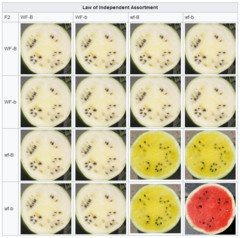Watermelons and muskmelons in SW Idaho
Hello everyone! :)
I'm growing lots of watermelon, this year (about 50 kinds), and I'm wondering who else is or has grown it in the high desert or steppes of Idaho, too. If you're from a colder, or wetter part of Idaho, I don't mind if you chime in, though.
What varieties have done the best for you? What part of Idaho are you in?
Anyway, this year, I'm still waiting on fruit, of course, but Yellow Doll F1 and Ancient are growing the most vigorously. I suspect that some of the currently less vigorous ones, like Navajo Red and my plants grown from saved seeds, will do fairly to very well. In the past, I've had good results with the following varieties:
* Red-seeded Citron
* Sugar Baby
* Verona (earlier than most, and bigger than Sugar Baby)
* Ledmon (on my second year, from saved seeds—the first year, from store-bought seeds, it was much smaller and had more issues; the second-year version was possibly a cross)
* An unknown yellow kind with loose (as opposed to crisp) flesh that smelled like pumpkins do.
Anyway, there are challenges to growing watermelon in my garden, and climate (to some degree), especially because of the compact soil, cool nights, dry air and the spider mites. So, that's why I'm listing varieties that do particularly well (in case it helps someone else with similar conditions).
Cantaloupes and other muskmelons are easier in a lot of ways, though (as long as they get plenty of potassium; I find that muskmelons improve with lots of potassium and basalt rockdust). I'm growing a lot of those, too (but more watermelons). In the past, the ones that have done the best include the following
* An unknown standard-looking, netted variety. It was very prolific and tasty.
* Ginger's Pride x Ha'Ogen F1, which had quite large fruits and was very prolific. The taste was a bit like bananas.
* Swan Lake honeydew, which was prolific and tasty.
We'll see what this year brings for the muskmelons.
Comments (19)
Mokinu
Original Author6 years agolast modified: 6 years agoIn 2017, it turned out that my favorite watermelons included Santo Domingo Winter (1st year), Black Diamond (1st year), Congo (2nd year), and a Congo cross (2nd year). But alas, I didn't thin most of the varieties in time (so they didn't get a fair trial, due to crowding). Santo Domingo Winter was among those that weren't thinned, but the rest of my favorites were thinned. I should note that Santo Domingo Winter, Ancient, and Yellow Doll F1 all had above-average vigor. Navajo Winter produced well, but I liked the taste of Santo Domingo Winter a lot more (and Santo Domingo Winter was a lot earlier). My favorite watermelon for smell was Wintermelon.
I watered a lot less than in previous years.
My favorite muskmelons in 2017 were Metki Dark Green Serpent, Colossal Creek, Gordo F1, and Ananas D'Amerique A Chair Verte.
Metki Dark Green Serpent melon is an Armenian cucumber, and probably my all-around favorite plant of 2017. It's very early, prolific, large, and very tasty (even when large); it keeps well; it quenches the feeling of thirst easily; it was easy-to-grow in our clay loam soil, whereas regular cucumbers have historically struggled in recent years.
My favorite muskmelons for a dessert-type flavor in 2017 were Ananas D'Amerique A Chair Verte (the wasps agreed), and Colossal Creek.
0Related Professionals
Peabody Landscape Contractors · Alamo Landscape Contractors · El Segundo Landscape Contractors · Hickory Hills Landscape Contractors · Lebanon Landscape Contractors · Middletown Landscape Contractors · Panama City Beach Landscape Contractors · Richmond Landscape Contractors · Salem Landscape Contractors · Santa Maria Landscape Contractors · Selden Landscape Contractors · Wallingford Landscape Contractors · Enumclaw Carpenters · Homestead Carpenters · St. Johns CarpentersMokinu
Original Author6 years agolast modified: 6 years agoFunny you should mention Red-seeded Citron. That's the one to have performed the best for me, in my garden (although it definitely wasn't the earliest). I think I got 15 fruits from one plant in 2015 (the ones that had finished growing got to a proper size). They seem like they'll keep indefinitely, practically. They take a really long time to decompose, too, if you happen to leave them outside in the sun. We had some in a room inside for I think over a year, but the room had a freezer that had had a bunch of stuff go bad in it, which made the room smell bad, and I think the fruit made me a bit sick when I ate some of it one time after it had aged significantly (so, I put some of those outside so they'd soften so I could mix them into the soil, but they never really softened; I had to crush them to get them to begin to decompose, but I couldn't crush them until they had been out for a really long time already, and they were reluctant to decompose even crushing; after probably over a year of being outside (after a year of being inside) the rinds left behind some tough shells filled with seeds; there are still some remains out there).
It seemed to be fairly resistant to spider mites and anthracnose (even on a foliar level). It was vigorous and grew over a large area.
They make a good water chestnut replacement in stir fry (just cut up raw strips of the flesh and then stir fry them).
I probably would have grown it again, every year, but that's a lot of stir fry (one fruit goes a long way). What else can I do with them? My attempt at making a baked dessert didn't work out so well (it tasted more like sweetened squash with the texture of baked apples). Maybe it would be good canned. I like the taste of the seeds when they're cooked (the shells are tough, but they're easier to eat when cooked).
Had the season been longer in 2015, I imagine it would have produced a whole lot more fruit.
I'm interested to know what a cross between it and a regular watermelon would be like. I thought maybe Navajo Red was descended from it (it has red seeds, and is a winter watermelon), but I didn't taste much of a semblance. The red seeds aren't the same color of red (not quite the bright, shiny nail polish look that Red-seeded Citron has). I got a lot of very small fruits from Navajo Red in 2017.
0Mokinu
Original Author6 years agolast modified: 6 years agoActually, I would lacto-ferment them if I grew them again! :) I should totally do that. I'm always looking for stuff to pickle. The flesh should be perfect for that.
Have you tried the Makataan watermelon? It's like a giant-fruited Red-seeded Citron with a darker green rind. That one might be great to use in crosses to get larger fruit in tough conditions (if it's as hardy as Red-seeded Citron). Cross it with Royal Golden, maybe, and try to get the yellow rind when ripe feature! :)
0Mokinu
Original Author6 years agolast modified: 6 years agoPink/red-fleshed watermelons taste the best (to me, at least; I'm partial to the pink ones) in our yard, so far. Yellow Doll F1 and Cream of Saskatchewan actually tasted quite good, but the taste was very faint and they weren't terribly sweet (it could be because they were under-sized; some kinds when under-sized don't taste nearly as good). The orange ones haven't had much taste or sugar, either.
My favorites for taste are these, in this order:
* Ledmon (watered well; this can taste absolutely amazing)
* Tom Watson (watered well; ditto)
* Santo Domingo Winter (dry conditions)
* Black Diamond (dry conditions)
* Verona (watered well)
* Congo and my Congo Cross (dry conditions)
* Fairfax (semi-dry conditions)
It's also worth noting that King Winter tastes like watermelon Jolly Ranchers (in both wet and dry conditions).
0- 6 years agolast modified: 6 years ago
The citron melons do well in my soil and even in dry crowded conditions so that is mostly why i like their genetics. Otherwise useless to me. You could make jam with b their pectin i guess if you add fruit and sugar. They are basically pure pectin.
Hybrids will resemble the citron melons greatly for the first couple generations. Will need to be backcrossed and/or heavily selected for several years to get something edible. Navajo red could be descended from a long time ago but i wouldn't know. Then again might not.
Haven't tried that citron, but added a large red- seeded citron from trade winds fruit and a few other red- seeded melons. And added golden midget back in again. I need to stop adding watermelons. But the yellow find feature would be clever. Citron melons already have a little yellowing in the rhind already and get more yellow when they get more ripe apparently. I haven't stored them that long though.
Funny you prefer the reds because for me i generally prefer the canary yellows as they are sweeter to my tongue. But i am not selecting for all yellows like Joseph is. I have had a few really good red ones and am keeping those in my population.
Salmon yellows like Hopi yellow and others taste blech to me Though. Yes there are at least two different kinds of yellows, one version is a dominant trait, the other is a recessive trait. Orange were ok but not outstanding to me. Crossed yellow-red swirls were interesting but similar to Orange, perhaps i did not harvest them at the right time that year. I am getting better at harvesting them ripe better every year.
http://cuke.hort.ncsu.edu/cgc/cgcgenes/wmgenes/gene12wmelon.html
here is my thread on my citron-watermelon hybrid project. I've shared seed with others to collaborate on it.
http://alanbishop.proboards.com/thread/9187/colorado-seeded-citron-watermelon-hybrids
Mokinu thanked keen101 (5b, Northern, Colorado) Mokinu
Original Author6 years agolast modified: 6 years agoSomeone should cross Makataan with Carolina Cross, Weeks NC Giant or such. It might be easier to make the world's largest watermelon with hardier genetics that are fit for the desert (provided Makataan is hardy; regular Red-seeded Citron might be hardier).
0Mokinu
Original Author6 years agoDo you ever graft your watermelons? I'd love to try something grafted onto Red-seeded Citron in my garden.
0Mokinu
Original Author6 years agolast modified: 6 years agoAlso, it could be great trying crosses with a citron watermelon and Sugar Baby Bush to get an even hardier and more prolific bush type.
I think I might grow RSC in the middle of Sugar Baby Bush and giant types, and see if I get any crosses.
0- 6 years agolast modified: 6 years ago
There was a discussion about watermelon genetics on the other forum. The discussion is still ongoing, but it prompted me to make a neat little picture to try and understand the watermelon flesh genetics a little better. I have simplified things a bit, and ignored a few other genetic oddities/genes, but for flesh here is a basic line of most dominant on the left and most recessive on the right as far as i can tell.
It is interesting you found the orange fleshed ones to taste pretty meh. I don't grow orange but i find the salmon yellows to be mealy and poor flavor. Perhaps it is the soil here. I imagine your soil is similar to mine so that may make a difference in what flavors taste better in our climates. Since salmon yellow sortof looks to be a sub-type of orange i'm not surprised at them having similar flavors in our region.
https://biolumo.com/index.php?title=Watermelon_Genetics
 Mokinu thanked keen101 (5b, Northern, Colorado)
Mokinu thanked keen101 (5b, Northern, Colorado) Mokinu
Original Author6 years agokeen101, Thanks for that! :) I've been wondering about dominance. That's valuable information there. So, the order is Canary Yellow, Scarlett Red, Coral Red (pink), Orange, Salmon Yellow, and White. I just write this in case the picture disappears some day.
My soil is a clay to clay loam type. I'm not sure what the dominant nutrients are. We added peat moss, worm castings, basalt rockdust and stuff last year and the year before. It's usually gray soil, but it's brownish this year—probably because we got less rain this winter/spring.
0- 6 years ago
Yeah i mean the discussion is still going on. Some discussion of whether Coral Red is the same as Pink or whether there is a difference. I think they are probably the same.
But yeah, that is the simple version based on what we can interpret from the data on that website. I guess there is another inhibitor gene that can turn a canary into a red. But i don't know how common that is.
Mokinu thanked keen101 (5b, Northern, Colorado) Mokinu
Original Author6 years agoAll the reds and pinks look pink to me, but some of them look pinker than others. In 2016, I had a *very* pink-looking 2nd year (possibly crossed) Ledmon that was the best-tasting watermelon I had ever tried. Another plant in the same spot produced a much redder fruit (which didn't taste the same).
I had a yellow watermelon one time that smelled like a pumpkin. Do you think that was Salmon Yellow? I'm pretty sure it wasn't Canary Yellow (it didn't look nearly as vibrant as Yellow Doll F1), but it looked much more yellow than the picture there. It had loose flesh, and was sweet, but not what I had hoped for. I don't remember the variety. It had flavor, but it wasn't my preference.
Is there a salmon red/pink, by chance? A red/pink fleshed watermelon I grew tasted a lot like that pumpkin-smelling one, except a whole lot better, IMO (I loved it), with firm, crisp flesh. I wonder if that might be a salmon red or salmon pink.
I wonder if crossing Salmon Yellows with Citron watermelons could make them taste better, by imparting a crisper flesh.
The yellows and oranges I've tried in recent years haven't had particularly loose flesh, however, but they didn't taste like that pumpkin-smelling one, either. They just didn't have a lot of flavor or sweetness.
0- 6 years agolast modified: 6 years ago
Well, i emailed that guy from the page and got some more info. seems i may have jumped the gun with my diagram, though it is partially correct, basically minus the white fleshed. I will stop hijacking your thread and allow others to comment.
Here is his reply:
[quote]There are several colors described that have not been studied for inheritance yet, including dark red, rose and pink.
Canary yellow is controlled by the C locus and is not part of the Y locus. It is epistatic to the Y locus.
White
is not part of the Y locus. White is controlled by 1 or 2 other genes,
and is epistatic to other colors. There is a team in China that is
publishing the inheritance of white.
Dr. Todd C. Wehner
Professor and Project Leader
Cucurbit and Stevia Breeding
Dept. Hort. Sci.
NC State University[/quote]I sent off another email asking if the photos i have listed are accurate
for the names they are place holding for. waiting for a response.Mokinu thanked keen101 (5b, Northern, Colorado) - 6 years agolast modified: 6 years ago
So i edited that page and photo to remove white from the list. My current understanding is this:
That
Canary Yellow is dominant to all colors unless the inhibit gene is
present. If the inhibit gene is present the flesh color defaults to red
or pink or whatever color is dominant next. And even though not all the
red and pinks have been studied, it sort of looks like the general trend
is the one with the most color is dominant to one that has less. With
the last one being Salmon yellow.It also sounds like White
might actually be dominant over Canary yellow and all color as well, so
if you have white fleshed in your population that may complicate things
quite a bit. I only have white fleshed in my population from Citron
melons. In one study the inheritance numbers were this in the F2
generation: 12 white, 3 yellow and 1 red. Which interestingly enough
reminds me of the 9:3:3:1 ratio that i looked at with the red podded
peas...(https://keen101.files.wordpress.com/2015/08/screenshot-3-1.png?w=700).
And yes, would indicate that two genes are at play with white fleshed
watermelon. Mokinu thanked keen101 (5b, Northern, Colorado)
Mokinu thanked keen101 (5b, Northern, Colorado) - 6 years ago
I'm amending my last post. It could be more than one gene, but this 12:3:1 inheritance looks more like one gene.
Mokinu thanked keen101 (5b, Northern, Colorado) - 6 years ago
hello shule am interested to know what kind of spiders was in watermelon ??
Mokinu thanked andreamelani90 Mokinu
Original Author6 years agolast modified: 6 years agoThis kind. They're actually not spiders. They're spider mites (which are mites). I don't know which kind of spider mite they are. The kind we have are pretty much invisible, pretty much always, since they're so small, but the early-ish damage looks like that you see in the first link in this comment. They usually don't cause visible watermelon symptoms until a certain part of the season.
They don't go in the watermelon fruits (as far as I know!—they're kind of invisible); they're on the plants (and on the surface of the rinds of the fruit).






keen101 (5b, Northern, Colorado)